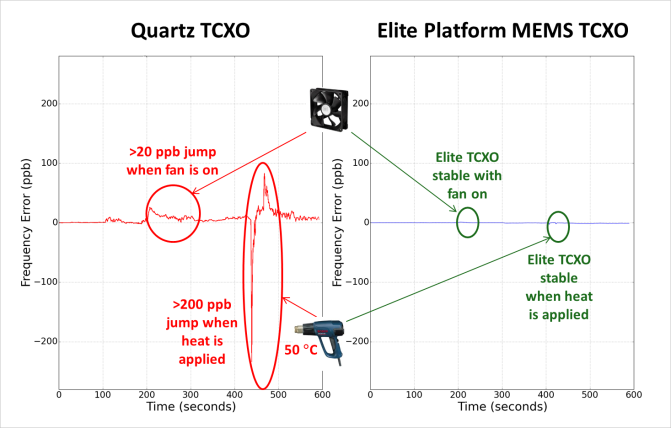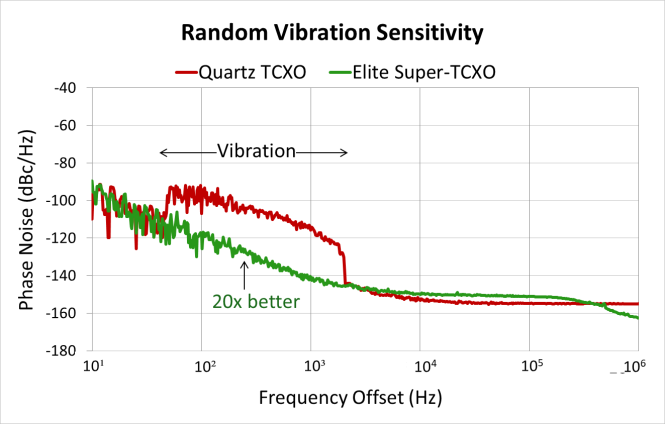Solving the Tough Timing Challenges of 5G Wireless Infrastructure
Timing is the heartbeat of any electronic system and 5G networks will be particularly dependent on the accuracy, stability and reliability of their clock sources. Traditional quartz timing devices used in 4G networks are faced with new challenges to support higher bandwidths and narrower channels of coming 5G networks. MEMS technology solves these problems, meeting all timing requirements while performing significantly better than quartz solutions in the presence of dynamic environmental stressors such as shock, vibration, and rapid temperature changes. In addition, a 100% semiconductor supply chain inherently provides MEMS solutions with superior quality and reliability compared to quartz, which is critical to supporting the quality-of-service planned for 5G applications.
Emerging Trends in 5G RRU Timing
The transition from 4G to 5G networks has resulted in two key emerging trends: cloudification and densification. Deploying cloud technology in core networks, or cloudification, is needed to enable real-time processing of voice and video applications. The connection between radio heads and base stations, which are point-to-point physical links in 4G, is established in 5G using packet-based networks maintained in the cloud. Time synchronization throughout this packet network requires adoption of new standards, including IEEE 1588 and evolved common public radio interface (eCPRI), that pose new challenges for timing performance and reliability.
At the same time, new mobile services are expected to increase broadband cellular traffic. To increase 5G data rates, the distance between base stations and user terminals will reduce, causing a corresponding rise in the number of cell sites and nodes in the network. This densification of radio access networks is a fundamental shift introduced by 5G networks, and is critical for increasing capacity in metro areas with a high concentration of users. Cellular radios will become ubiquitous throughout the 5G urban landscape, where they will appear mounted on telephone poles, lamp posts, building corners, and curbside municipal power-supply cabinets. Such densification will subject 5G radios to a broad range of environmental conditions that demand a higher level of performance for timing devices.
Packet Delay Variation
Service operators planning to offer new real-time 5G applications require time-synchronized networks. IEEE 1588 and eCPRI technologies enable this time synchronization over packet networks. One consequence of connecting a central unit (CU) to a remote radio head (RRH) over a packet network is the time-delay variation of packets traveling between ends of a link. Such packet delay variation (PDV), also called network jitter or packet jitter, adds noise to time values derived from the network, and therefore degrades the user experience of real-time services. PDV is caused by many factors in the system. For example, any active network element that processes packets, such as a switch, is subject to varying load conditions. This load is a function of the number of packets to process and the complexity of that processing, both of which vary over time with network usage, and are key sources of PDV.
The impact of PDV in the RRH can be reduced by increasing the stability of the oscillator used within its IEEE 1588 servo loop. This servo loop acts as a low-pass filter to the incoming PDV, and a high-pass filter to timing noise injected by the oscillator. Thus, the quieter, or more stable, the oscillator, the lower the servo-loop bandwidth can be adjusted to filter the input PDV and output a clock that faithfully recreates the time scale present at the other end of the link. This “cleaned” output clock is then used to accurately discipline the oscillator, and the feedback loop repeats.
The stability of an oscillator therefore directly influences the timing accuracy derived by a 5G network. The most common stability specification for an oscillator is frequency-stability-over-temperature. Often, oscillators are specifically selected for this number, commonly assumed to be a proxy for overall stability. However, this specification fails to capture the stability of an oscillator when subjected to thermal gradients. Here, the frequency versus temperature slope, also referred to as dF/dT, can be a important factor in timing accuracy. Figures 1 and 2 illustrate the advantage of SiTime Elite Platform™ TCXOs compared to competitive quartz devices for providing excellent stability in changing thermal environments.

Figure 1: SiTime SiT5356 (1 to 60 MHz) and SiT5357 (60 to 220 MHz) ±100 ppb TCXOs feature industry-leading low frequency-versus-temperature-slope (dF/dT), which improves PDV filtering and therefore timing accuracy, necessary for deploying successful real-time services.

Figure 2: SiTime SiT5356 (1 to 60 MHz) and SiT5357 (60 to 220 MHz) ±100 ppb TCXOs provide superior stability during rapid thermal gradients compared to tier-one ±50 ppb quartz-based TCXOs. The SiT5356/5357 performance is enabled by proprietary DualMEMS™ architecture and TurboCompensation™ temperature-compensation schemes [1].
The electronics in 5G radios are convection cooled, and are therefore subject to a wide variety of thermal conditions. SiTime MEMS-based devices do not require physical covers nor dedicated PCB keep-out regions, often required by quartz devices for thermal protection to maintain datasheet specifications.
Environmental Shock and Vibration
Densification in 5G networks means radios will be mounted on a variety of outdoor objects that are subjected to vibration from many sources, including trucks, trains, cars, wind, and thunder. Oscillators deployed in these radios need to maintain stable performance during vibration to prevent dropped links and associated operator fines. Figure 3 illustrates the robustness of SiTime Elite Platform TCXOs under vibration compared to quartz TCXOs, which degrade during vibration and can go out of specification potentially for as long as the vibration continues. This can be minutes for a long freight train nearby, or even longer on a windy day. Such robustness is inherent to the MEMS architecture, eliminating expensive housings or thermal and mechanical protection commonly required by quartz devices.

Figure 3: SiTime MEMS oscillators provide excellent shock and vibration performance compared to quartz devices, enabling more options for densification for 5G networks. Data shown is for 7.5 g RMS per MIL-STD-883F, Method 2026.
Quality and Reliability
Densification also demands a higher level of quality and reliability to minimize service calls to an expansive deployment of 5G radios. Precision TCXO and OCXO devices in 5G RRUs, not present in 4G, present new locations for servicing failures that can be difficult to access.
SiTime MEMS oscillators have inherent advantages over quartz device that allow them to perform more reliably in extreme environments. SiTime developed the MEMSFirstTM process, in which resonators are fully encapsulated in silicon and enclosed within a micro-vacuum chamber [2]. The combination of very small mass of the resonator and its stiff silicon crystal structure makes them durable and extremely resistant to external stresses such as shock and vibration. And unlike quartz, all-silicon MEMS resonators have negligible aging. Additionally, optimally designed voltage regulators integrated into the oscillator circuitry reject power supply noise to maintain stability in noisy environments. These features lead to higher quality and reliability levels, and fewer field failures, for SiTime MEMS oscillators compared to quartz devices.
Comparing SiTime MEMS and Quartz Devices
Key benefits of SiTime Elite Platform TCXOs compared to traditional quartz TCXOs for use in 5G RRU equipment include:
- 50x better quality (DPPM)
- 30x improved reliability (MTBF)
- 20x better mechanical shock resistance (MIL-STD-883 Method 2002)
- 10x better frequency stability in the presence of rapid thermal gradients
- 3x better random vibration resistance (MIL-STD-883, Method 2007)
- No frequency jumps or activity dips
- Excellent power supply noise rejection
Because of these benefits, an Elite Platform TCXO designed into 5G RRU equipment enables a single radio design to be deployed globally, regardless of environmental conditions. Such a design saves development time, speeds time to market, and streamlines production. The robust timing provided by these radios, once deployed in the field, will minimize disruptions to 5G services and ensure a better user experience.
………………………………………………………
[1] SiTime Corp., “DualMEMS and TurboCompensation Temperature Sensing Technology”, Technology Paper.
[2] SiTime Corp., “SiTime’s MEMS First and EpiSeal™ Process”, Application Note 20001.